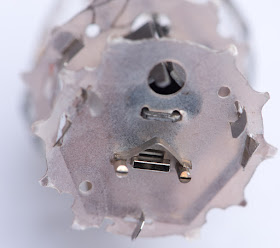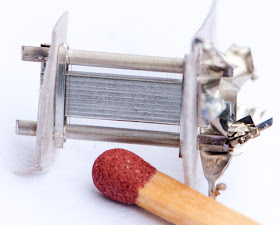During the last half year or so, all tubes which got presented in this series had been quite old developments from the 1920ies to 1930ies. So I decided to pick a more modern one for the last Tube of the Month post in 2015. A small high frequency triode, developed in the 1960ies by Telefunken. Meet the EC8010.
Readers of my blog are aware of my fondness for the EC8020, which got covered twice already as Tube of the month. The EC8010 is the small sister of the EC8020 and was most likely developed first.
 Both tubes share the same 9 pin noval base and pinout. They have similar amplification factors. The EC8010 is a bit higher with 60 vs the 55 of the EC8020. The big difference is in the transconductance which is about double in the EC8020. Still the EC8010 comes with an impressive gm of 28mS. Due to that the EC8010 is often referred to as 'half a EC8020'. In fact a EC8020 could be emulated by using two EC8010 in parallel. Maximum plate dissipation is about 4W which is again half of the EC8020s. In terms of dimensions, the EC8010 has about half the diameter at about the same height. Due to the extreme scarcity of the EC8020 using two EC8010s could indeed be an approach if the transconductance of the former is needed.
Both tubes share the same 9 pin noval base and pinout. They have similar amplification factors. The EC8010 is a bit higher with 60 vs the 55 of the EC8020. The big difference is in the transconductance which is about double in the EC8020. Still the EC8010 comes with an impressive gm of 28mS. Due to that the EC8010 is often referred to as 'half a EC8020'. In fact a EC8020 could be emulated by using two EC8010 in parallel. Maximum plate dissipation is about 4W which is again half of the EC8020s. In terms of dimensions, the EC8010 has about half the diameter at about the same height. Due to the extreme scarcity of the EC8020 using two EC8010s could indeed be an approach if the transconductance of the former is needed. The EC8010 is much easier to find at lower prices. Two of them would only need more heater current than a single EC8020. For all technical details of the tube see the Telefunken data sheet. I never compared two EC8010s in parallel to a EC8020 in an actual circuit so can't comment about any degradation in sound with such an approach. If paralleling is attempted the tubes should be carefully matched. Such high transconductance tubes often vary a lot from sample to sample. And in case of the EC8010 the data sheet gives the amplification factor as 'about 60'. While in the EC8020 data sheet it is listed as '= 55'. This was certainly done for a reason and I would expect some variation in amplification factor between tubes. Since I have more stock of EC8020s than EC8010, I never was tempted to use the EC8010 as substitute and also do not have enough samples to verify considerable differences between samples. I have one same which differs from the others a bit. More about that below. Let's first have a look at the plate curves:
The EC8010 is much easier to find at lower prices. Two of them would only need more heater current than a single EC8020. For all technical details of the tube see the Telefunken data sheet. I never compared two EC8010s in parallel to a EC8020 in an actual circuit so can't comment about any degradation in sound with such an approach. If paralleling is attempted the tubes should be carefully matched. Such high transconductance tubes often vary a lot from sample to sample. And in case of the EC8010 the data sheet gives the amplification factor as 'about 60'. While in the EC8020 data sheet it is listed as '= 55'. This was certainly done for a reason and I would expect some variation in amplification factor between tubes. Since I have more stock of EC8020s than EC8010, I never was tempted to use the EC8010 as substitute and also do not have enough samples to verify considerable differences between samples. I have one same which differs from the others a bit. More about that below. Let's first have a look at the plate curves:A nice set of curves with good linearity for such a high transconductance tube. Here the measurement of a tube on the curve tracer:
Here two sets of plate curves of the two tubes from my stock which differ the most between each other. As can bee seen there is not only a difference in transconductance but also in the amplification factor:
As far as I am aware, EC8010s were made by Telefunken, Siemens and Valvo. I have also seen some with the National brand name which is owned By Richardson Electronics. Not sure if they manufactured these themselves or rebranded them. Interestingly those National tubes carried both tube designations, EC8010 and EC8020. From the physical appearance and measurements however they had been EC8010. In the 1970ies and 1980ies it was common practice to sell one tube with several designations of types which are similar. However in this case this was going a bit too far.
The EC8010 also has an american 4 digit designation, 8556.
Above some Siemens EC8010 tubes in the characteristic blue/orange packaging.
Close up to the tube:
The boxes:
A few more photos of the Siemens tube:
Valvo EC8010:
Some close ups:
Siemens and Valvo in comparison. Very similar construction with only subtle differences:
The EC8010 has a very unique construction characteristic which I have not seen in any other tube. While the cathode and grid assembly is usually completely surrounded by the plate, only one side of the cathode and grid face the plate in this tube:
A close up shows the fine grid wires:
Unfortunately I don't have any Telefubnken EC8010 to show. So let's proceed with detail photos of the internals. For this I cracked open a dead tube:
Removing the glass envelope gives a much better view to the internals:
Here we can see the cathode and grid which are facing towards the top into empty space:
A close up to the grid:
The top showing the ring which held the getter material before flashing:
Some more views:
The silver cage like structure around the outside was probably only there for mechanical stabilisation.
A view from the side opposite to the grid, with cooling fins of the plate:
Another view to the grid and close up:
The top mica disc and getter holder removed:
Cathode extending out of the second mica disc:
Removing the heater wire:
Removing the outer 'cage' gives yet a better view to the cathode grid and plate:
This is taken from the side so that the gap between grid and plate is nicely visible.
Shot from the grid side:
Here the entire plate structure is nicely visible:
Grid and cathode detached from the rest:
Close up:
The plate:
For size comparison with a finger in the picture:
Close up:
Some more views of the grid and cathode:
Some photos with a match for size comparison:
What a marvellous piece of engineering! Now some photos of a tube in operation.
As expected the entire cathode can be seen from one side.
Close up with the grid wires visible:
I hope you enjoyed this last Tube of the Month post for 2015. Stay tuned for more tubes to be shown in 2016!
Best regards
Thomas




























































Hi,
ReplyDeleteI have some "Amperex, Made in France" labeled EC8010s. They were made at La Radiotechnique, Suresnes, probably in 1971. They are in yellow and green North American Amperex boxes.
Best regards,
Bo Lindström
Hi Ale,
ReplyDeletenice review,as always...
Please, do you have spice model about your measurements ?
Thanks.
Best regards.
Carlo Alberto.
I am not Ale...
Delete